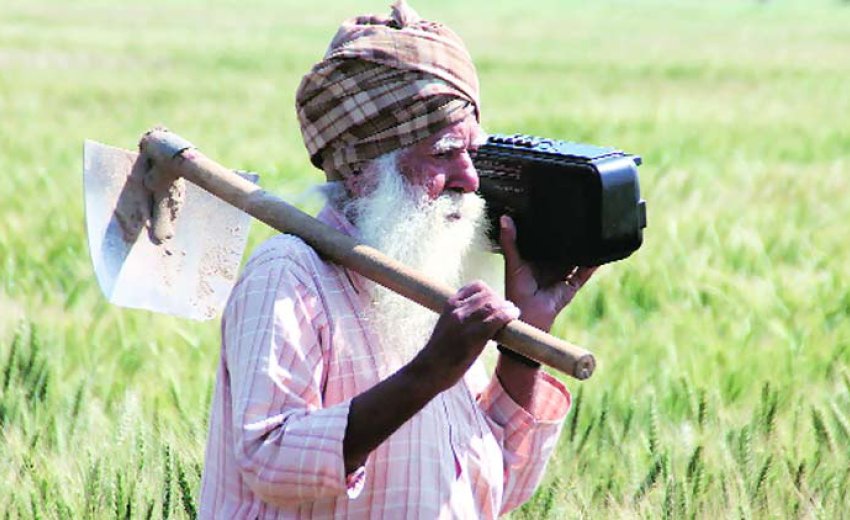"With just 1.5 per cent of India's land area, Punjab produces 20 per cent of the country's wheat and 12 per cent of its rice. It provides 60 per cent of the Central government's reserve stocks of wheat and 40 per cent of its reserves of rice, the country's buffer against starvation. Punjab's amazing productivity made it possible for India to feed most of its growing population that tripled from 350 million when the country became independent in 1947 to more than 1.2 billion people today."
- Mira Kamdar
 India witnessed unprecedented food production in the 1970s and the 1980s, and this phenomenon - implemented primarily by the Sikh farmers of Punjab - was proclaimed as the Green Revolution.
India witnessed unprecedented food production in the 1970s and the 1980s, and this phenomenon - implemented primarily by the Sikh farmers of Punjab - was proclaimed as the Green Revolution.
The country was transformed from a food-deficient nation to a food-sufficient nation. The seeds of the Green Revolution were sown when Dr M.S. Swaminathan invited Dr Norman E. Borlaug to India in 1963. Borlaug provided to Indian scientists, including those at Punjab Agricultural University, seeds of some improved wheat varieties developed in Mexico. India achieved self-sufficiency in wheat in 1972 and in rice in 1974.
This happened on account of the scientific achievements of agricultural scientists who developed new crop varieties and corresponding farm technologies, hard work of farmers, and government policies conducive to agricultural growth.
Mira Kamdar, a Senior Fellow at the World Policy Institute, New York, from 1992 to 2006, wrote in 2008: "If a single institution can take credit for bringing the Green Revolution to [India], it is Punjab Agricultural University."
Today, agriculture is the source of livelihood for more than 65 per cent of India's population. Agriculture accounts for 27 per cent of the nation's gross domestic product (GDP) and contributes 21 per cent to total exports. Agriculture also supplies raw materials to industries.
For many years, India has been comfortable in its ability to produce food and feed people. It has had surplus foodgrains too. The nation appears to have achieved "food security". The main food security crops are wheat and rice, produced in Punjab, Haryana, and Western UP - the "Food Bowl" of India.
For more than a decade now, Punjab has been consistently contributing to India's Central Grain Reserve at least 60 per cent wheat and up to 40 per cent rice. The contribution of the "Food Bowl" states to the Central Grain Reserve is 98 per cent wheat and 65 per cent rice. This remarkable achievement has come at a cost though - the underground water table has gone down drastically and soil health has been adversely affected.
Today, a trip through Punjab and Haryana would show that after harvest foodgrains (wheat and rice) lie in the marketplace (mandis) in the open for months to rot. Last year, during a meeting with Union Finance Minister Parnab Mukherjee, I brought to his attention the issue of lack of adequate grain-storage facilities and consequent wastage of foodgrains in the mandis.
There was an increased funding for the development of storage facilities in last year's budget. Unfortunately, millions of tonnes of foodgrains are still being "stored" improperly in the open. We can ill afford such post-harvest losses. We are wasting the precious water and other inputs used to produce this grain. Much more needs to be done in the area of foodgrain storage.
For agriculture to serve as an engine of growth and poverty alleviation, we must ensure that agriculture grows. Agricultural growth cannot be achieved without investing in agricultural research and development.
In an article, "Reducing Poverty and Hunger in India: The Role of Agriculture", Deputy Chairman of the Planning Commission, Sardar Montek Singh Ahluwalia, writes, however, that public investment in agriculture began to decline in the 1980s and that initially the decline was offset by increasing private investment in agriculture. He further states, "Since the mid-1990s private investment in agriculture has stagnated while public investment has continued to decline." Research and development are the prerequisites to the development of new technologies. Agricultural universities in India have proved this, as their R&D led to the development of new crop varieties and new technologies. Agriculture aside, if we simply look at India's overall investment in R&D, a very gloomy picture emerges.
Research and development are the prerequisites to the development of new technologies. Agricultural universities in India have proved this, as their R&D led to the development of new crop varieties and new technologies. Agriculture aside, if we simply look at India's overall investment in R&D, a very gloomy picture emerges.
India lags behind other nations in spending on R&D. For example, India's per capita R&D investment is $5.5 as compared with $11.7 for China and $705 for the US. According to a UNDP 2008 report, India's allocation for R&D was just 0.8 per cent of its GDP whereas that of China was 1.2 per cent and that of the US 2.7 per cent. Japan spends more than 3 per cent of its GDP on R&D.
A strong commitment is required on the part of the Government of India to improve the R&D scenario, particularly for agriculture.
Here one is reminded of a speech by John F. Kennedy he delivered during the joint session of the US Congress in 1961, requesting funds for the space programme. He said, "First, I believe that this nation should commit itself to achieving the goal, before this decade is out, of landing a man on the moon and returning him safely to the earth."
This vision became a reality when Man landed on the moon in July 1969.
This type of commitment is needed in the case of agriculture in India.
Alarm bells are ringing in various quarters about India's vulnerability in sustaining foodgrain production to feed its ever-growing population (about 15 million new faces are added every year).
Mira Kamdar commented on Punjab's role in Indian agriculture as follows:
"With just 1.5 per cent of India's land area, Punjab produces 20 per cent of the country's wheat and 12 per cent of its rice. It provides 60 per cent of the Central government's reserve stocks of wheat and 40 per cent of its reserves of rice, the country's buffer against starvation. Punjab's amazing productivity made it possible for India to feed most of its growing population that tripled from 350 million when the country became independent in 1947 to more than 1.2 billion people today."
She further wrote, "In 2001, India even began to export grain, though critics claim this impressive achievement was gained at the expense of India's poor.
Only two years later, in 2003, India had to reverse the funnel and import grain, something it had not done in decades. Every year since then India has imported more and more of its food."
Dr. Sanjay Rajaram, a former Director of CIMMYT's wheat research programme, revealed while speaking at a seminar in October 2007: "Between 2004 and 2007, the average production of wheat was around 72 million tonnes in India. By 2020, India would need 100 million tonnes. Between 2002 and 2007, productivity was around 2.8 tonnes per hectare. By 2020, it should be 3.8 tonnes per hectare. If India fails to enhance production, leading to a huge gap between supply and demand, there could be social upheavals and rampant hunger and malnutrition."
This should alert us all to the possibility of India slipping down the "food security" ladder.
Recently, Dr Swaminathan stated, "We are on the verge of a disaster. We will be in serious difficulty if food productivity is not increased and farming is neglected." He warned that the country would face a food crisis if agriculture and farmers were ignored.
Is India's food security vulnerable?
Many think so.
At a recent annual meeting of the vice-chancellors of Indian agricultural universities, a serious concern was expressed about India now being on the verge of becoming a foodgrain-importing country. Only a couple of years ago, India did import some wheat from Australia. Do we want to become an importing nation again? If we do not want to go that route, we must invest more in agricultural development.
India's position is precarious in food production because of erratic rainfall patterns. For example, in 2000-01, foodgrain production was 196.8 million tonnes (rainfall was 91 per cent of the long-term average or LTA). In 2002-03, foodgrain production was down to 174.8 mt because rainfall was 81 per cent of the LTA. In 2005-06, foodgrain production went up to 208.8 mt (rainfall being 99 per cent of LTA), and in 2007-08, it reached 230 mt. India has not exceeded 230 mt in the last one decade.
By 2021, however, India will need to produce 276 mt of foodgrains to feed its people. By 2050, the country will need to double its foodgrain production. It will be an extremely difficult task if India does not increase its outlay for agricultural R&D and simultaneously take appropriate measures to reduce population growth.
[The author is Vice-Chancellor, Punjab Agricultural University, Ludhiana, Punjab]
February 1, 2010

